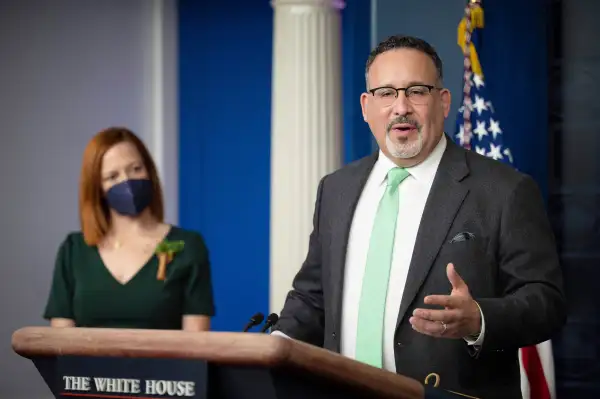Over 1 Million Student Loan Borrowers Just Became Eligible for Pandemic Relief

More than one million student loan borrowers just got access to pandemic relief measures that pause federal loan payments and collections activities.
The Department of Education announced Tuesday that borrowers with Federal Family Education Loans that are in default will now qualify for current pandemic protections that were already available to most federal borrowers. That means their loans will not accrue interest and will not be sent to collections. Defaulted loans are loans that are at least nine months late.
“Our goal is to enable these borrowers who are struggling in default to get the same protections previously made available to tens of millions of other borrowers to help weather the uncertainty of the pandemic,” Secretary of Education Miguel Cardona said in a news release. The department added that qualifying borrowers who've made payments or had payments forcibly collected from them in the past year are eligible for refunds.
Since March 2020, borrowers with Direct Loans and federally held Perkins or Federal Family Education loans have been in an interest-free payment pause, and borrowers with those loans who were in default were protected from collections efforts, meaning the government stopped garnishing wages of defaulted borrowers.
But the key term there is “federally held.” While the existing relief measures cover most of the country’s roughly 45 million borrowers, the measures didn’t apply to all borrowers. That’s because many FFEL loans — which were distributed before 2010 — are held by private banks and guaranty agencies, and some of the 1.9 million existing Perkins loans are held by colleges, and also are ineligible for the pandemic payment pause. Altogether, that has left more than eight million borrowers with loans that were ineligible for the pandemic protections.
Advocates have been pushing for the past year to expand relief to those borrowers, but Tuesday’s announcement from the Education Department is very narrow. It only applies to those FFEL borrowers with loans in default. As a result, borrower advocates criticized it as not going far enough.
“Unfortunately, this action is incomplete — it does nothing for the more than five million commercial FFEL borrowers who are not in default,” Seth Frotman, executive director of the Student Borrower Protection Center, said in a statement.
The SBPC, along with the National Consumer Law Center, wrote in a letter to the Education Department last month that by the time the current payment pause ends in September, most borrowers will have had a year-and-a-half without having to pay their student loans. But the typical FFEL borrower with privately held loans will have had to make $5,700 in payments. That amount could have paid for four months of rent, based on the median price of a two-bedroom apartment, or over a year of typical utility bills, according to the consumer groups.
The disparate treatment of commercially held FFEL loans from other federal loans can be particularly frustrating for borrowers, who had no choice in whether they have a commercially held FFEL loan or a federally held one. From the perspective of borrowers when the loans were issued, they were all federal loans. There's been no official announcement from the government about why privately held FFEL and Perkins loans were left out of the pandemic assistance, but experts previously told Money it's likely because the government would have to arrange to pay those private companies that hold the loans.
Still, this policy change will help some borrowers who are struggling most. Defaulting on your student loans can seriously damage your financial health, and Tuesday's move will help mitigate some of its most dire consequences. Defaulting can disqualify borrowers from accessing income-driven repayment plans, which tie your monthly payments to how much you’re earning and offer forgiveness of any remaining balance after at least two decades of payments. More importantly, the government can seize your wages, Social Security payments or tax refunds if you don’t pay your student debt.
All of that activity will now stop for borrowers with defaulted FFEL loans. The Education Department said the action would help more than 800,000 borrowers who were at risk of having their federal tax refunds seized to repay a defaulted loan. The relief will be retroactive to March 13, 2020, the start of the COVID-19 national emergency, meaning that if you’ve had a tax refund seized or wages garnished in that time, you’re eligible to get that money back. The Education Department says it will issue those refund automatically.
More from Money:
President Biden Says Student Loan Borrowers Can Postpone Payments for Another 8 Months
Borrowers Are Getting Bombarded With Student Loan Relief Calls. It's a Scam

